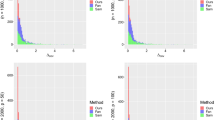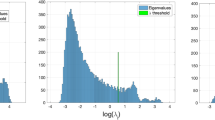Abstract
The estimation of high dimensional covariance matrices is an interesting and important research topic for many empirical time series problems such as asset allocation. To solve this dimension dilemma, a factor structure has often been taken into account. This paper proposes a dynamic factor structure whose factor loadings are generated in reproducing kernel Hilbert space (RKHS), to capture the dynamic feature of the covariance matrix. A simulation study is carried out to demonstrate its performance. Four different conditional variance models are considered for checking the robustness of our method and solving the conditional heteroscedasticity in the empirical study. By exploring the performance among eight introduced model candidates and the market baseline, the empirical study from 2001 to 2017 shows that portfolio allocation based on this dynamic factor structure can significantly reduce the variance, i.e., the risk, of portfolio and thus outperform the market baseline and the ones based on the traditional factor model.
Similar content being viewed by others
References
Ye R, Ma T, and Wang S, Improved anovae of the covariance matrix in general linear mixed models, Journal of Systems Science and Complexity, 2011, 24(1): 176–185.
Xu K, A new estimator of covariance matrix via partial Iwasawa coordinates, Journal of Systems Science and Complexity, 2017, 30(5): 1173–1188.
Engle R F, Autoregressive conditional heteroscedasticity with estimates of the variance of United Kingdom inflation, Econometrica, 1982, 50: 987–1007.
Bollerslev T, Modelling the coherence in short-run nominal exchange rates: A multivariate generalized arch model, The Review of Economics and Statistics, 1990, 72(3): 498–505.
Tsui T A K C, A multivariate generalized autoregressive conditional heteroscedasticity model with time-varying correlations, Journal of Business and Economic Stats, 2002, 20(3): 351–362.
Lanne M and Saikkonen P, A multivariate generalized orthogonal factor GARCH model, Journal of Business and Economic Statistics, 2007, 25(1): 61–75.
Hu Y P and Ruey S T, Principal volatility component analysis, Journal of Business and Economic Statistics, 2014, 32(2): 153–164.
Engle R F, Ledoit O, and Wolf M, Large dynamic covariance matrices, Journal of Business and Economic Statistics, 2019, 37(2): 363–375.
Fan J, Fan Y, and Lü J, High dimensional covariance matrix estimation using a factor model, Journal of Econometrics, 2008, 147(1): 186–197.
Guo S, Box J L, and Zhang W, A dynamic structure for high-dimensional covariance matrices and its application in portfolio allocation, Journal of the American Statistical Association, 2017 112(517): 235–253.
Fama E F and French K R, The cross-section of expected stock returns, Journal of Finance, 1992, 47(2): 427–465.
Bollerslev T, Generalized autoregressive conditional heteroskedasticity, Journal of Econometrics, 1986, 31(3): 307–327.
Xu F, Sun M, and Dai Y, An adaptive Lagrangian algorithm for optimal portfolio deleveraging with cross-impact, Journal of Systems Science and Complexity, 2017, 30(4): 1121–1135.
He C and Meng W, Dynamic portfolio choice under the time-varying, jumps, and knight uncertainty of asset return process, Journal of Systems Science and Complexity, 2012, 25(5): 896–908.
Wu H and Li Z, Multi-period mean-variance portfolio selection with Markov regime switching and uncertain time-horizon, Journal of Systems Science and Complexity, 2011, 24(1): 140–155.
Markowitz H, Portfolio selection, The Journal of Finance, 1952, 7(1): 77–91.
Haugen R A and Baker N L, The efficient market inefficiency of capitalization-weighted stock portfolios, The Journal of Portfolio Management, 1991, 17(3): 35–40.
Jagannathan R and Ma T, Risk reduction in large portfolios: Why imposing the wrong constraints helps, The Journal of Finance, 2003, 58(4): 1651–1683.
Nielsen F and Aylursubramanian R, Far from the madding crowd*-volatility efficient indices, Research Insights, MSCI Barra, 2008.
Ban G Y, El Karoui N, and Lim A E, Machine learning and portfolio optimization, Management Science, 2018, 64(3): 1136–1154.
Kimeldorf G and Wahba G, Some results on Tchebycheffian spline functions, Journal of Mathematical Analysis and Applications, 1971, 33(1): 82–95.
Huber Peter J, Robust estimation of a location parameter, The Annals of Mathematical Statistics, 1964, 35(1): 73–101.
Huang W, Nakamori Y, and Wang S Y, Forecasting stock market movement direction with support vector machine, Computers and Operations Research, 2005, 32(10): 2513–2522.
Ma P, Huang J Z, and Nan Z, Efficient computation of smoothing splines via adaptive basis sampling, Biometrika, 2015, 102(3): 631.
Goldstein T, O’Donoghue B, Setzer S, et al, Fast alternating direction optimization methods, SIAM Journal on Imaging Ences, 2014, 7(3): 1588–1623.
Hansen P R and Lunde A, A forecast comparison of volatility models: does anything beat a GARCH(1, 1)?, Journal of Applied Econometrics, 2005, 20(7): 873–889.
Author information
Authors and Affiliations
Corresponding author
Additional information
This paper was supported by National Natural Science Foundation of China under Grant No. 11771447.
Rights and permissions
About this article
Cite this article
Peng, S., Guo, S. & Long, Y. Large Dynamic Covariance Matrix Estimation with an Application to Portfolio Allocation: A Semiparametric Reproducing Kernel Hilbert Space Approach. J Syst Sci Complex 35, 1429–1457 (2022). https://doi.org/10.1007/s11424-021-0168-3
Received:
Revised:
Published:
Issue Date:
DOI: https://doi.org/10.1007/s11424-021-0168-3




